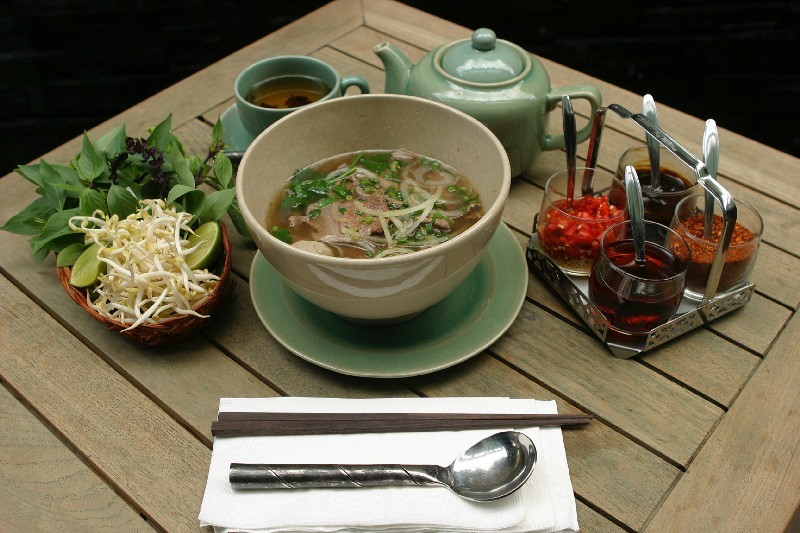By Bryan Quoc Le | 150 Food Science Questions Answered
I grew up eating Vietnamese food.
That can mean a lot of things to a lot of people, but for me, that meant an endless supply of white jasmine rice moistened with a broth made from boiled bok choy or cauliflower, and eaten with a freshly grilled fillet of salmon. Or it meant warm French baguettes stuffed with grilled marinated pork, and accompanied with pickled carrots, daikon, and mint. On special occasions, it might even be homemade pho noodle soup, made from a rich combination of fragrant herbs and spices simmered with the stock of a whole chicken.
Regardless, there was one key feature in all these meals that gave depth, flavor, and character — nuoc mam, or fish sauce. Without this strange and wonderful ingredient, most Vietnamese meals would fall flat and leave one with nothing more than a dissatisfied palette. In many dishes, fish sauce is critical. The saltiness and umami-lifting notes of fish sauce can transform dishes, adding the right punch of flavor to vegetables or enhance the savory notes found in the mouth-watering meats and grilled fish ever present on a traditional dinner platter.

Vietnamese nuoc mam is made from high-quality, fresh anchovies, salted with half to a third of its weight in sea salt, and left to ferment in stone jars for years at a time. The enzymes naturally present in the tissues of the anchovies begin to break down the muscles and innards of the fish. The high salt content protects the fish from fermenting sideways or growing toxic microorganisms. As the fermentation progresses, friendly bacteria resistant to the excessive salt used in the fermentation start taking a foothold and continue the liquification of the fish. These two processes turn the proteins and DNA that make up the bulk of the anchovy bodies into flavor-magnifying small molecules. The most important of these biomolecules are the amino acids, glutamic and aspartic acids, and the nucleic acids inosine and guanosine monophosphate. Together, these compounds can synergistically pump up the flavor dial in ways that can rival even the most advanced synthetic flavor enhancers used in the food industry.
Some of the best Vietnamese fish sauces are made on a small tropical island off the coast of Vietnam called Phu Quoc. The fish sauces found there are fermented for decades, not unlike a prized whiskey or aged cheddar. And like extra virgin olive oil, the most desirable ones are the first presses known as nuoc mam nhi. A numerical designation is given to fish sauces, which represents the amount of nitrogen (in the form of amino acids and proteins) available in the product. “50⁰ N/1 L” is the maximum achievable grade associated with nuoc mam nhi, with lower grades going down the scale.
However, if you ever have a chance to visit the production facilities on the island, just remember the island of Phu Quoc itself emanates a perpetual, overpowering scent reminiscent of decaying fish, for rather obvious reasons.

One of the basic barometers to measuring skill in cooking Vietnamese food is one’s ability to make nuoc cham, or dipping fish sauce. A proud moment came in my life when I finally broke my culinary glass ceiling and made a nuoc cham that impressed even my wife, a self-proclaimed gastronome with the chops to distinguish high-quality Vietnamese food after years of experience eating Vietnamese cuisine.
This, of course, was after countless trials that had ended in failure.
The secret? I used Red Boat 40⁰ N fish sauce.
No, this isn’t an advertisement for Red Boat (although it does sound suspiciously like one, right? I promise I’m not marketing!) The truth is that I wanted to share this incredible revelation in my life because for the longest time, I simply thought I was no good at cooking Vietnamese food. My mom could readily wield Three Crabs or Phu Quoc brand fish sauces (both produced by the company Viet Hoang) and use them to effortlessly flavor her delicious cooking. I, on the other hand, would turn my kitchen into a pungent living hell as the odors of the fish sauces overwhelmed my dishes. Of course, I know my mom is much more skilled in the art of cooking from years of experience. Indeed, I needed something more potent to cover up my personal disadvantages. Plus, I wanted to show my wife that I was not going to demean myself with instant soup packets or pre-cooked meals just to have Vietnamese food at home.

By Vincent Liew at Pexels
I originally discovered Red Boat at the Trader Joe’s in Wisconsin (of all places). This was quite a surprise because I had no idea there was a market for Vietnamese fish sauces for American shoppers. I had heard of this crème de la creme fish sauce brand while reading on Chowhound, and I wondered to myself, “Is this truly that good?” Personally, I had grown up with the Phu Quoc brand, so I just didn’t know anything else.
My interest was piqued.
I bought that little bottle of amber liquid and brought it home, impatient to learn of its tasty secrets like a wine aficionado passionately uncorking a bottle. I swiftly poured a tablespoon into a small dish and added the necessary ingredients to pass the first test towards great Vietnamese flavor — minced garlic, lime juice, chili hot sauce, water, sugar, and white vinegar.
I stirred. I stirred. I stirred some more.
One would think my background in chemistry would give me the patience to stir with a refined air of sophistication. But I wanted to know if there was a haven out there in the culinary world for me, where I could finally bring the flavors of Little Saigon with me to my current home in the Great American Midwest. I wanted to once again taste home-cooked Vietnamese meals without fear that I might have to toss a cup of poor-quality dipping fish sauce down the drain.
I tasted.
I wept with joy.
I grabbed my wife’s hand and jumped with glee.
Halleluiah! I had finally made a decent nuoc cham!

By Lightscape at Unsplash
The truth is that Red Boat is a little more expensive compared to other fish sauces on the market, which are cheaper because they are sometimes adulterated with less expensive flavoring additives, diluted down, press from less expensive fish, or quickly fermented over only a few months. Red Boat uses high-quality anchovies that are allowed to ferment over the course of a year or more using a traditional method, and the sauce itself can reach some of the highest possible protein levels for maximum flavor intensity. Recognizing these factors, I can feel confident that Red Boat will deliver the flavor that I need for my cooking.
Between my wife’s graduate stipend and my research assistantship, this brand can seem more like a luxury than a basic necessity. But trust me when I say, I have never gone wrong with my cooking since Red Boat sailed into my life and rid me of my gastronomical insecurities. My wife and I can now finally replicate some of the more intermediate dishes, and we always feel confident that our meals will turn out for the better.
It just goes to show you how important a good nuoc mam is for Vietnamese cuisine. Honestly, I sometimes like to think that I’m buying insurance to protect myself from those sad days of bad cooking.
Days that are thankfully behind me.
P.S. If you’re ever feeling brave and ambitious, the authors of Fermenter’s Club have a thorough recipe for fermenting homemade fish sauce. Be forewarned — the process is pretty stinky and can cause your significant other to question your life choices.
P.P.S. For an interesting sensory research paper on the difference in taste profiles between fish sauce and salt, read here.

Bryan Quoc Le | 150 Food Science Questions Answered
IFTSA VP of Digital and Social Media (2019-2020)
Bryan is the author of 150 Food Science Questions Answered (Rockridge Press, 2020) and a Ph.D. candidate in Food Science at University of Wisconsin-Madison studying the health effects of garlic and onion flavors. He received his B.S. and M.S. in Chemistry at the University of California, Irvine. In another life, he walked 2,000 miles from California to Louisiana in six months, and learned that eating tuna and peanut butter every day was not meant for the average human body. After he met his wife, he learned that there was more to good food than canned goods and smoothies. While not juicing onions and pressing garlic, Bryan likes to run half-marathons, discover interesting cuisines with his wife, and help entrepreneurs develop great food products.






Leave a Reply